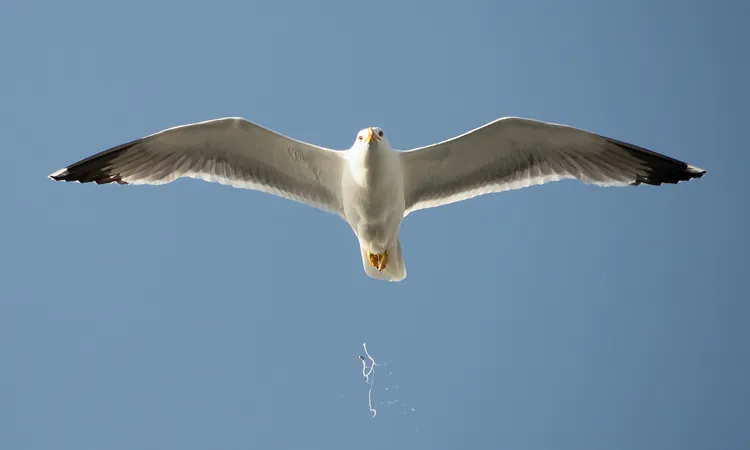
The Surprising Impact of Seabird Poop on Ocean Ecosystems
2025-08-19
Author: Ming
The Hidden Role of Seabirds in Marine Nutrient Cycles
From their melodious dawn songs to their graceful flight over the waves, seabirds have always captivated our hearts. But beneath their enchanting exterior lies a crucial ecological function: they are vital nutrient transporters, interlinking the terrestrial and marine ecosystems.
While the nutrient-recycling prowess of whales is well-documented, the influence of seabird droppings on ocean health was largely an enigma—until now. A recent study has illuminated the unexpected ways in which these birds contribute to marine life, even from miles offshore.
When Seabirds Prefer Aerial Bathrooms
On the remote islands of Japan, researchers observed a peculiar behavior among streaked shearwaters. Instead of the usual pooping habits seen in other birds, these seabirds were found releasing their droppings while flying, often every 4 to 10 minutes.
Lead researcher Leo Uesaka from the University of Tokyo initially examined seabird takeoff patterns. "To my surprise, I found them dropping feces constantly while in flight. What began as an amusing observation has turned into an important discovery about marine ecosystems," he explained.
The Nutritional Goldmine Hidden in Seabird Droppings
Rich in nitrogen and phosphorus, seabird feces are known to enrich soils and bolster coastal environments. However, the effects of their waste in the open ocean had been less understood.
With an estimated population of 424 million, streaked shearwaters have the potential to deliver a significant nutrient supply to the ocean, supporting a thriving plankton population that is fundamental to marine food webs.
This process is akin to the "whale pump," where baleen giants recycle nutrients through their excretions. Just like whales, large seabird populations could play a role in enhancing ocean productivity, revealing that their bathroom habits are far more impactful than they might appear.
Behavior: A Strategy for Better Hygiene and Health
In a remarkable observation, researchers equipped 15 shearwaters with tiny cameras, documenting nearly 200 bathroom events. The footage revealed that almost all their droppings occurred while airborne, with very few incidents happening on water.
This behavior may help keep their feathers clean, minimize the risk of pathogens, evade predators, and deliver nutrients directly to the ocean below. By taking off to poop, the birds maximize efficiency and reduce the likelihood of getting caught by predators.
Uncovering Patterns in Excretion Behavior
Uesaka noted that the shearwaters, with their elongated wings suited for gliding, must flap vigorously to gain altitude. Consequently, they weigh the risk of an accident during a stressful takeoff against the benefits of lightening their load.
With each bird ejecting about 30 grams of waste per hour—over 5% of its body weight—this consistent removal may support their gliding efficiency. Such findings challenge previous estimates regarding seabird excretion habits on land.
Implications for Health and Marine Ecosystems
While an individual seabird's droppings might seem insignificant, the collective impact of millions can be monumental. These nutrients can travel great distances from breeding grounds, nourishing distant parts of the ocean—especially where large seabird colonies congregate.
However, this behavior also raises concerns about pathogen spread, such as avian influenza, which could affect marine wildlife if released in shared feeding areas.
Future Research and the Importance of Seabird Behaviors
The exact reasons behind the seabirds' rhythmic excretion patterns remain unclear, prompting Uesaka to seek further investigation. He aims to use more advanced cameras and GPS technology to trace their droppings across the ocean.
This study underscores how even seemingly trivial behaviors can shape larger ecosystems. As Uesaka aptly said, "Feces are important, but often overlooked. They hold essential keys to understanding life in our oceans."



 Brasil (PT)
Brasil (PT)
 Canada (EN)
Canada (EN)
 Chile (ES)
Chile (ES)
 Česko (CS)
Česko (CS)
 대한민국 (KO)
대한민국 (KO)
 España (ES)
España (ES)
 France (FR)
France (FR)
 Hong Kong (EN)
Hong Kong (EN)
 Italia (IT)
Italia (IT)
 日本 (JA)
日本 (JA)
 Magyarország (HU)
Magyarország (HU)
 Norge (NO)
Norge (NO)
 Polska (PL)
Polska (PL)
 Schweiz (DE)
Schweiz (DE)
 Singapore (EN)
Singapore (EN)
 Sverige (SV)
Sverige (SV)
 Suomi (FI)
Suomi (FI)
 Türkiye (TR)
Türkiye (TR)
 الإمارات العربية المتحدة (AR)
الإمارات العربية المتحدة (AR)